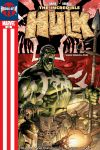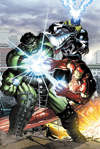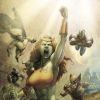|

By Ben Morse
This month marks five decades of gamma bombs, science gone awry and, of course, plenty of smashing as The Hulk celebrates his 50th anniversary!
Since his 1962 debut in INCREDIBLE HULK #1, the Green—and occasionally Grey—Goliath has become not only one of the most iconic and beloved characters in comics, but across pop culture, from his classic TV series to “Marvel’s The Avengers.” Over the next five days, we’ll celebrate the greatest hits—and we do mean hits—of Bruce Banner, his friends, his foes, and his family with Hulk Week!
Up first, Marvel Senior Editor and overseer or all things Hulk Mark Paniccia fills us in on his own personal history with ol’ Green Genes as well as what’s to come as the next 50 years kick off…
Marvel.com: How long have you been editing the Hulk books?
Mark Paniccia: I've been on Hulk for about eight years starting with issue #83 released in 2005. I took over with the House of M tie-ins where we put Hulk in Australia as a monarch. Peter David built some connectivity to what Fred Van Lente and I were doing over in AMAZING FANTASY with A.I.M. Fred's actually delving deeper into those connections in the soon-to-be- released original graphic novel, HULK: SEASON ONE.
Marvel.com: What do you consider the high points of your tenure?
Mark Paniccia: The whole run, of course, has been an awesome experience; but since you said "points" I'll pick a few that were really outstanding for me.
“Planet Hulk” is probably most special. It was at my first Marvel creative summit when we started to discuss where Hulk would be headed after House of M. [Former Editor-in-Chief and current Chief Creative Officer] Joe [Quesada] wanted to get him someplace—another world or dimension—where he could cut loose, be “Hulk the Barbarian” basically. And we discovered that Daniel Way was working on this stand-alone project called “Peace in Our Time” where Banner is duped by S.H.I.E.L.D. into a space mission. It seemed like a natural thing to me to use one as a platform for the other. The ball began rolling and we started building the story into a larger one with the Illuminati being responsible for the plan of getting Banner and Hulk—the most dangerous superhuman—off the planet. The rest is history. The world building with Greg Pak was really special. We'd meet once a week and go over outlines and maps and characters and the history of the planet Sakaar. We were giddy at the end of every meeting because we knew it was going to rock. And getting Ladrönn to do covers? It just proved the stars were aligned for this epic.
World War Hulk was absolutely a high point as it was the big story that “Planet Hulk” fed in to. There were some challenges along the way because now we were going back to Earth and needed to coordinate with other books and make sure it all fit post-Civil War. We had been operating autonomously for 14 issues and getting back into the field was pretty exciting. We had a much bigger story in mind that gave it a much more global feel but we didn’t have the room in the publishing plan. In the end it all came together splendidly. The chance to work with Johnny Romita Jr. and Klaus Janson was too good to be true and I still pinch myself whenever I think about it and I don't wake up, so it must have happened. The other thing that came from it I thought was really important was the notion that Banner was always running the numbers when Hulk hit someone into a building or smashed something big, that he was calculating and coordinating on a subconscious level to make sure no one died. That made Hulk/Banner more heroic to me and gave other media a way to avoid the kind of collateral damage questions one has when they see destruction on a Hulk-sized level.
And the Red Hulk saga was very cool. It was something I had completely different plans for, even seeded a new character to become this new Hulk, but Joe convinced me it should be [General Ross] and he was right. I had a great conversation with Jeph Loeb and he took it from there with Ed McGuinness. Then we started building a plan with Greg Pak so we could have two books going concurrently, then dovetail into what became World War Hulks.
Working with Jeph on HULK was something I’ll never forget. We became really good friends over the process and I remember going through some tough times with something and the guy was always there for me. And we had a lot of good times, too. We got away with some pretty fun stuff like punching The Watcher and introducing the Offenders. Sigh…now I want to do a book with them.
The HULK stuff that followed with the other Jeff—Parker—and artist Gabriel Hardman was a great follow-up experience from Mr. Loeb and Mr. McGuinness. Parker took that torch and ran all the way up several mountain tops with it. I would smile ear to ear when I got his scripts. I knew where he was going but never knew how he'd get there so there was always this indescribable excitement when I’d get that e-mail from him with a word attachment. I'd throw something at him like “Planet Red Hulk” and he'd be like, "Ok, that'll work with what I'm doing. I’ll have it over in a few days. It’s perfect for this new idea I have" and I'd get this real blast of a script. Parker scripts are so fun to read we'll have to publish one sometime.
Marvel.com: How did the idea to give The Hulk, long a solitary character, a "family"—the She-Hulks, Skaar, A-Bomb, even Red Hulk, etc.—come about?
Mark Paniccia: The “Hulk Family” started to build with the notion that Scorpion—from AMAZING FANTASY #7—could be Banner's child. We never wanted to answer that question and never did. Just keep it a mystery like they did back in the day with Wolverine’s past. But everything beyond that just fell into place. Several of us thought Hulk's marriage to Caiera was a great opportunity to create SKAAR: SON OF HULK and continue the barbarian Hulk vibe.
And we did this one shot with Hulk and Thundra called HULK: RAGING THUNDER. Lyra—who would later be named by Van Lente—was the twist ending of Parker's story, revealed to be the narrator. I didn't think she'd ever come back actually; just a one-off type of thing. But I was asked to do a limited series with her later and bring her into the current time line. So we really couldn't ignore her when it came to World War Hulks. And it was nice to have another female character in the mix.
Marvel.com: What do you think it has added to the mythos?
Mark Paniccia: The thing I liked about having all these Hulk-based characters was that it added to the gravity of Banner's guilt, to see something he had brought into the world continue to affect the people around him, whether it was someone he loved like Betty or hated like Ross or cared for deeply like Rick. And it also gave the Marvel Universe the beginnings of a counter balance to the mutant gene. That was something I always wanted to do: an X-Gene Vs. Gamma-mutated DNA war. In any case, it gives Hulk fans a variety of characters to experience, creators a deep toy box to play with and Marvel Studios a long shelf of content to pick from.
And of course there’re the toys. There’s been a toy made from each one of the big arcs I’ve worked on, starting with the House of M action figure. What a blast that was to see a design I was involved with as a toy, holding it in my hands and wishing I could tell seven-year-old Mark that this was the kind of stuff I had to look forward to. It would have made homework that much easier to do. There have been Planet Hulk, World War Hulk and Red Hulk action figures and there will be more coming.
Marvel.com: What's your first memory of The Hulk? What kind of impression did it leave on you?
Mark Paniccia: My first memory was, I think, from a subscription ad in a Marvel comic. I was intrigued as to how this big, ugly green monster could fit in the world of super heroes.
Marvel.com: Why do you think The Hulk endures as a character and concept?
Mark Paniccia: He resonates in several levels. I think we all wish we could get big and smash our problems. There’s definitely a wish fulfillment/fantasy aspect to that. And we probably all have felt like Banner when we've hurt someone close. Both are very human aspects to what is a deceptively simple concept.
Marvel.com: What's your favorite aspect of Bruce Banner besides his alter ego?
Mark Paniccia: His nobility. Here’s a guy who is working on a weapon of mass destruction with the same intent as someone like Richard Jordan Gatling—who invented the machine gun—a device that could be used to end a war quicker and result in less loss of life. And then he selflessly runs out during the gamma bomb test to save the life of Rick Jones, knowing full well he could die himself. I mean, wow, this character—who’s been portrayed in all kinds of lights over the years—is really a very noble guy inside. That’s something I find very fascinating and cool.
Marvel.com: What are some of your favorite Hulk stories and runs?
Mark Paniccia: My very favorite was [writer/artist John] Byrne’s run because it was drawn well and he did something really different and bizarre by splitting Hulk and Banner. A very cool and intriguing idea and it gave me something really new to sink my teeth into as a reader. But my all-time favorite story was INCREDIBLE HULK ANNUAL #7 with Angel, Iceman and the Master Mold Sentinel. I remember reading that thing over and over at the store and finally, when I had the money from turning in pop bottles—yes I call soda “pop” and I did return bottles for comic money; I am old—I bought it and read it over and over till the pages started falling out. I actually felt bad for the Sentinel when Hulk relentlessly smashed him into scrap metal. It was so good and the art by Byrne and Bob Layton was amazing!
Marvel.com: Who are the Hulk's greatest villains?
Mark Paniccia: I think the best is M.O.D.O.K. I mean, sure there are other greats—like The Leader—but the giant head on a floating chair is hard to beat. And I love M.O.D.O.K. 2.0, definitely not the same M.O.D.O.K. but just as good. And I have to tout the new villains that Jeff Parker created in HULK. From Zero/One to Black Fog to Omegex, this rogues gallery has some of the strongest bad guys conceived in comics in a long time. Gabriel Hardman’s designs for them are instant classics.
Marvel.com: Who are the most memorable members of his support cast?
Mark Paniccia: There’s Rick for sure and of course Betty, but I think, and I may be partial because I’ve spent a lot of time with him now, that Thaddeus Ross is the best. What a great foil to Banner and what a great fate for Ross to become the Red Hulk. We’ve had a fantastic opportunity to delve deeper into his psyche and give the guy an arc of redemption and a chance to be a hero instead of a pain in the culo—that’s what my Italian grandma always threatened to spank—and fans have found him surprisingly interesting.
Marvel.com: What's next for the Hulk books?
Mark Paniccia: Well, let me plug what’s now for the Hulk books and then tease the future. Hopefully you all are enjoying Jason Aaron’s run on INCREDIBLE HULK. Jason’s got a really great handle on the character and is building a conclusion to his run that’s well worth every bottle deposit you can get—if anyone still acquires comic money that way. His current arc, “Stay Angry,” leads into a three-parter that will blow your mind with the answers to the crazy mysteries Jason’s introduced and some big fights with heavy hitters like Wolverine, The Thing and Doctor Doom! If you haven’t picked it up, get the trade of the Aaron/[Marc] Silvestri/[Whilce] Portacio run and grab a copy of issue #7.1 and 8—and 9 will be on sale 6/13.
As for Red Hulk, the “Mayan Rule” arc has started with HULK #53—the cover is hard to miss—by Jeff Parker and one of my favorite artists today, Dale Eaglesham. Red Hulk has to go up against the newly-returned Mayan Pantheon and things won’t be pretty—except, of course, Dale’s portrayal of Mayan Goddess Ixchel. This really could be the end of Red! There are some great guest stars in the arc that are worth mentioning like the She-Hulks, A-Bomb, Machine Man—who people really dug from the “Hulk of Arabia” arc—and our good buddies the Northern heroes of Alpha Flight.
Now, what’s next? The only thing tease I can give is that we will dare to go into a new direction later this year. How’s that for cryptic and ominous?
Marvel.com: With The Hulk arguably at his highest profile in the public consciousness following the “Marvel’s The Avengers,” how do you and your crew plan to capitalize?
Mark Paniccia: The main goal is to put out great product. We aim to entertain our readers and deliver big, cool arcs that give new readers a good jumping on point. There’s no better plan than to have an awesome selection of material for all the new readers exposed to the character thanks to the movie and great collections that fans can recommend to their comics curious friends.
We’re also celebrating the 50th anniversary of The Hulk this year. Half a century of the strongest hero in the Marvel U! Here’s to another 50 years and a big thanks to all the readers and retailers who supported the books and the many talented creators who made the character(s) so great.
Hulk Week continues tomorrow as we chat with HULK writer Jeff Parker!
|


















